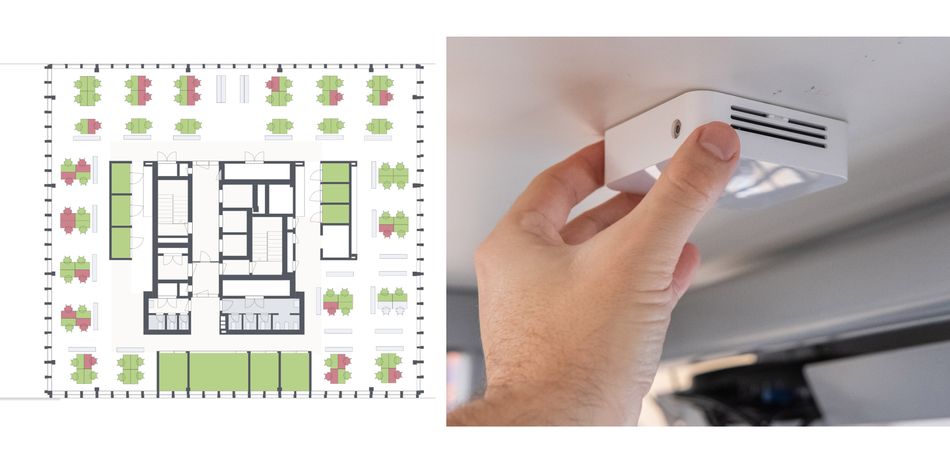What are LPWANs and why do they matter to IoT?
IoT hinges on the ability to send periodic data long distances with low power.
Internet of Things
IoT or the Internet of Things is the term used to describe the network of physical objects or “things” that are embedded with sensors, software, and other technologies for connecting and exchanging data with other devices and systems over the Internet. The low cost of chips and the availability of wireless networks mean almost anything can become part of the IoT network. Adding sensors to otherwise ‘dumb’ objects gives them a level of intelligence that can be used to build smart systems such as your connected home, automated workspaces, or environmental sensing systems. However, sensors are only one part of an IoT system which also requires a network to connect and exchange data and a method of interpreting and reading that data, which is done by a software application.
IoT networks
IoT is possible thanks to the advent of wireless networks. There are many different network types, each network type has particular properties and characteristics suitable for different IoT scenarios. The current maturity and continued development as well as the deployment of this array of networks directly reflect what types of IoT scenarios can be implemented and where.
These network types range from low power cellular networks such as NB-IoT and long-range radio networks such as LoRaWAN, Sigfox to local personal networks such as Bluetooth and RFID. The selection of a connectivity option depends on the IoT applications it is serving, with each requiring drastically different functions. The IoT connectivity option that is amazing for one application may be unsuitable for another.
The majority of IoT devices, especially those in smart city and industrial sectors, don’t require the same speed and bandwidth of consumer cellular devices to communicate. However, they do have other specific requirements such as longevity and low power consumption.
This article focuses on Low Power Wide Area Networks (LPWAN). It will discuss the specific type of networks in use under this umbrella term and how LPWANs are integral to the continuing innovation and relevant application of IoT.
LPWAN Technology Overview
LPWANs are designed to allow long-range communications at a low bit rate. LPWAN is not a standard but a broad term encompassing various implementations and protocols, both proprietary and open-source, that share common characteristics, namely low power, and wide area. It is important to note these properties in comparison to other wireless network protocols such as local RF networks that include Bluetooth and RFID, cellular M2M, or mesh networks like ZigBee.
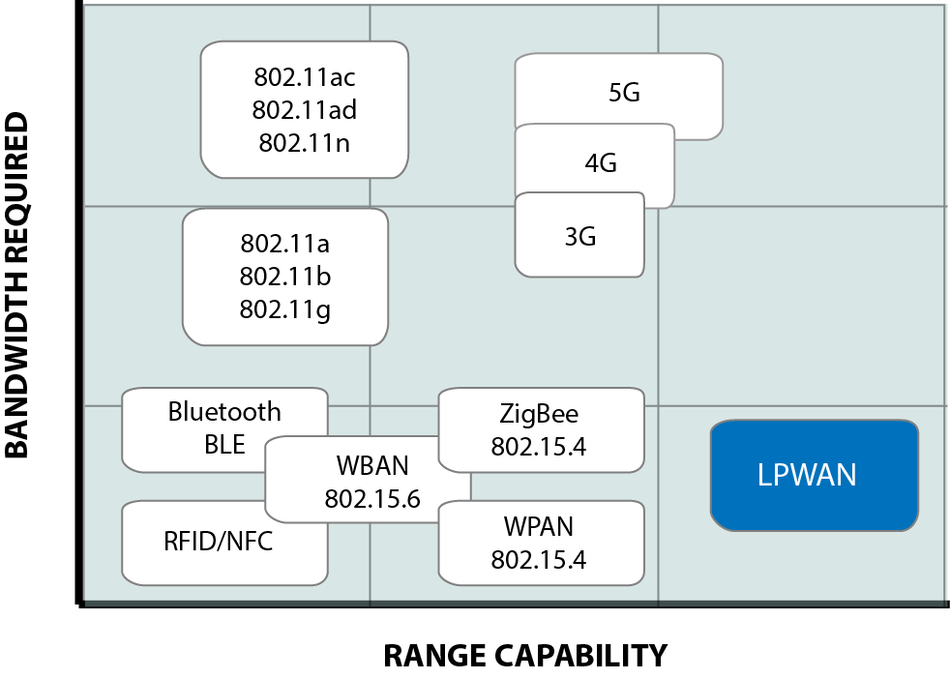
LPWANs are useful for IoT scenarios where devices need to send small data over a wide area while maintaining battery life for an extended period of time. There are several connectivity technologies in the LPWAN space the most prominent include:
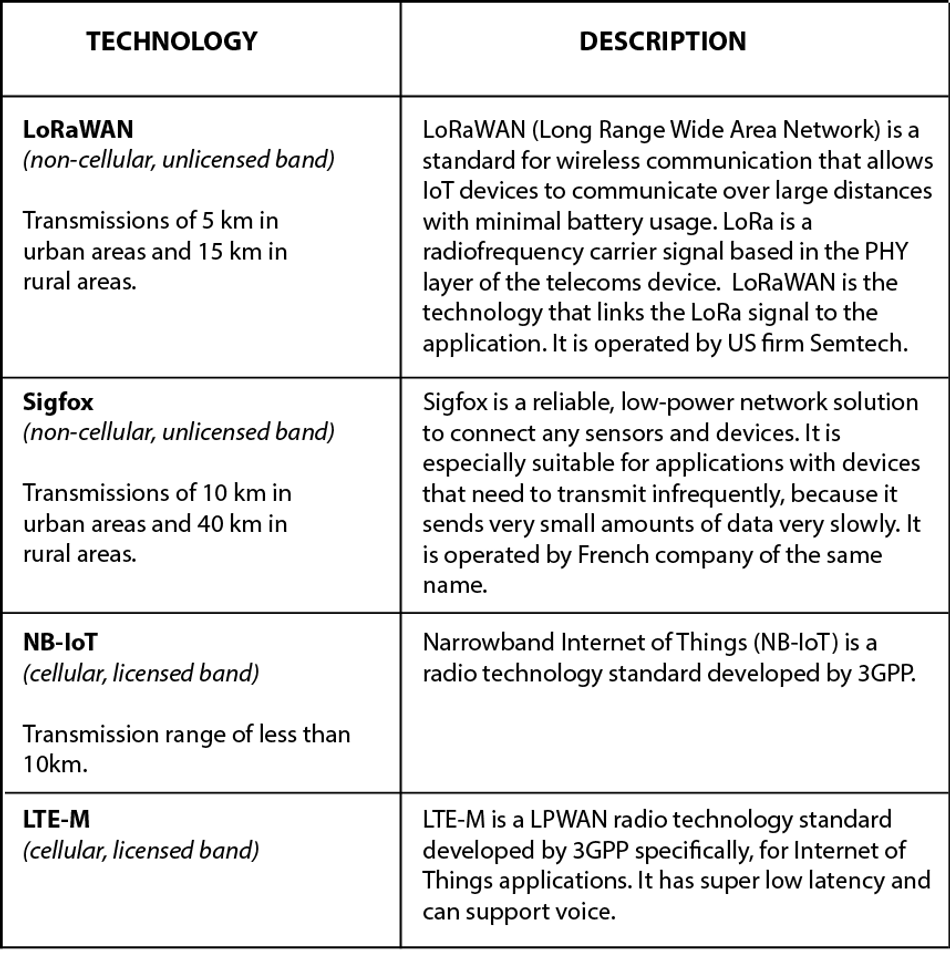
Why do LPWANS matter to IoT?
LPWANs are critically important to the overarching concept of IoT and its expansion. In many ways LPWANs are the backbone of a value-driven IoT network as they provide the opportunity for devices that usually don’t have sensors or their own power supply, to become truly connected. By transforming almost anything into a data-gathering device with low cost, low power sensors, and using LPWANs to connect and distribute this data, smart networks are created that can improve efficiency, data collection, industrial process and be used in research and environmental monitoring - meeting many of the goals of the IoT vision.
Consumer IoT relies on the high-speeds of 4G and 5G wireless services to provide applications such as connected smart homes, remote car retrieval, and entertainment. Often the items in these IoT networks are already relatively high tech, have their own power supply, and can have some information retrieved from them regardless of their connection. These networks are in frequent use with high bandwidth.
In contrast, LPWANs offers IoT applications the opportunity for devices to send small amounts of data periodically over remote networks that span large distances and use battery-powered devices that need to last many years. The devices in these networks can include typically non-powered, non ‘smart’ items such as agricultural gates, bins, bridges, or walkways.
LPWANs achieve their range and low power capabilities by only sending small packets of information periodically upon waking from an external trigger or at a pre-programmed interval.
Opportunities and challenges
The advantages of LPWANs are clear in applications where networks require periodic or inconsistent data transfer over long distances for a significant amount of time. Due to the range and simplicity of LPWAN data packets, sensors can even report from underground, in challenging climates, and from significant distances from gateways or towers.
However, there are limitations to LPWANS, they are unsuitable for use cases requiring data to be transferred frequently and/or in large volumes. So detailed images, videos or lengthy audio is unsuitable to be transferred over an LPWAN.
Some non-cellular LPWANs may also be unsuitable for applications where the transfer of data is considered ‘mission critical’ due to possible interference due to band sharing. Open-air LPWAN devices such as something on top of a tower that is sending faint signals in sub-GHz open bands may encounter interference from high-energy signals operating just above the GHz boundary.
Non-cellular LPWANs sometimes use unlicensed bands - these are the bands left open by government for industrial, science, and medicine so they must share access to the radio spectrum with other devices. This sharing requires regularization to ensure fair spectrum access for all devices and to prevent potentially harmful interference as described above.
Cellular LPWAN networks are inside the licensed spectrum and are offered by mobile network operators. They were developed with the 3rd Generation Partnership Project (3GPP) and GSMA.
Recommended reading: Critical Asset Monitoring with LPWAN
Maturity of the technology
With the advent of the cellular LPWAN, there is now more flexibility in the definition of “low-power” and “wide-area”. As the options for connectivity technology grow it’s essential there isn’t a temptation for one choice to be predicted as a winner. Different technologies suit different applications and the industry must take care to avoid the hype around particular protocols diluting a nuanced approach with a view to local contexts.
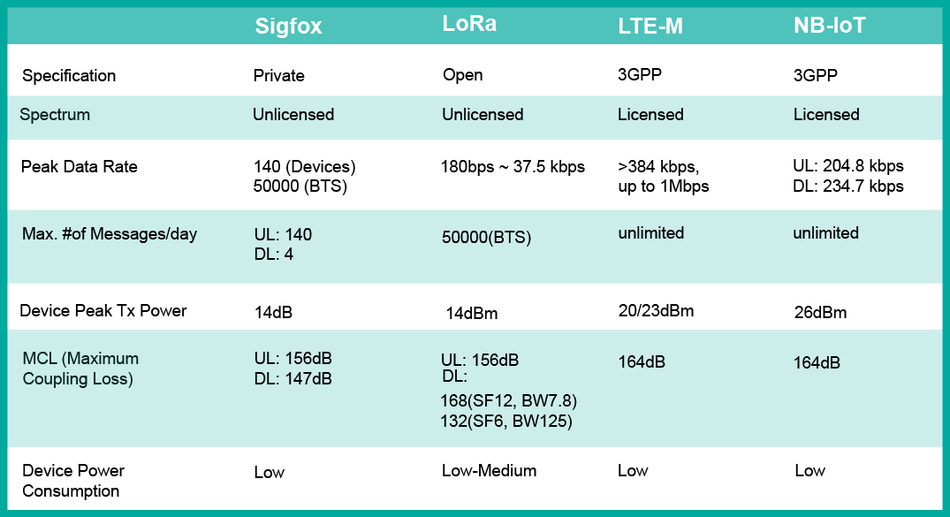
Market share & European landscape
Critical to IoT success is the wide deployment of LPWAN networks. LoRa has been rapidly deployed in most countries in the world, with all but one European country connected. Sigfox has strong coverage in western Europe and has rollout plans for Scandinavia, Austria, and Poland as well as North and South America. NB IoT and LTE enjoy wide global coverage, this map shows the mobile IoT commercial launches to-date.
In Europe, IoT solutions where cross-border networks are likely to be common such as logistics and waste management there need to be particular attention paid to the network type and provider to ensure the continuity of the relevant LPWAN network. In this regard, Sigfox enjoys an advantage as it is a single product operated by a single company with approximately 60 countries partially or totally covered to date.
LoRaWAN networks, on the other hand, are operated by different private companies in each European country, for example, Belgium and Luxembourg have Proximus, in Switzerland its Swisscom, the Netherlands uses KPN. In France, there are two operators, Orange and Bouygues while the UK has Connexin and IOT Networks. Germany has a choice between 3 public operators Digimondo, Minol Zenner, and Netzikon. Italy has 4 operators: A2A Smart City, Axatel, Telemar, and Unidata. But despite the rich landscape, most of these operators are not interconnected which may make it difficult for a sensor to switch from one network to another. This potential issue with continuity of connection is being addressed through roaming agreements between providers and with regulation at a national level.
LPWANs IoT case studies
LoRaWAN
A common application for LoRaWAN is the Smart Facility / Smart Building field. ISS, one of the world’s leading facility services companies is embracing the use of IoT based smart facility services across their services. For example, smart facility management enables ISS customers to track and analyze workspace occupancy therefore optimizing space management. By installing occupancy sensors in buildings, it becomes possible to improve the management of workspaces with new digital solutions. Infrared sensors mounted under personal desks or in meeting rooms allow property and office managers to see at a glance which areas are used more frequently than others (Figure 4). This type of system will become increasingly important as room occupancy rates and contact tracing become essential knowledge in a post-pandemic world.
Other smart building applications include:
Air monitoring
Air monitoring uses stationary or mobile IoT-enabled sensors to map and monitor the air quality inside high-occupancy spaces such as schools and hospitals. This data can inform cities of building management to make better decisions about ventilation, hygiene, occupancy rates, or similar.
Smart cleaning
Smart cleaning applications might include services such as those offered by Soobr which offers clients the ability to plan cleaning choreographies based on levels of higher use and urgency. In these instances, LoRa is a solid LPWAN choice as the data being transferred has a low bandwidth and long-distance. LoRa also allows the user to set up their own network in situations where data security or ownership are critical.
Sigfox
Sigfox is suitable for a variety of applications. International company Amberg Loglay uses Sigfox to develop service on demand systems for logistics on construction sides. On large construction sites with many moving parts and large numbers of workers, there may be several freight lifts on the site, each of which must be operated by lift attendants. With a service-on-demand system, there is not one attendant for each lift but one person operates several. The button solution serves to call the lift attendant/driver to the respective lift. While simple enough sounding this can provide huge efficiency increases on large infrastructure and building projects.
As Sigfox is operated by a private enterprise it is excellent for larger businesses who need completely remotely managed networks. A critical deciding factor between Sigfox and LoRaWAN is the network coverage. In some areas, you may have one but not the other, which will influence the decision-making process.
NB-IoT
NB-IoT is used in solutions for waste disposal companies, utilities, and transport companies. By attaching sensors with low energy consumption and long service life to the waste containers, it is possible to centrally monitor and predict the container's filling level. This enables improved planning of disposal tours and thus increases the efficiency of waste management. A concept study completed by Swiss logistics company Live Track aimed to evaluate the savings and potential of an IoT based waste monitoring system. The study which monitored glass collection in west-central Switzerland showed huge benefits in cost reduction, environmental impact, and collection efficiency. The total distance traveled by waste collection vehicles fell from over 800 km to approximately 540 km (over 30% decrease) in the evaluated period of 16 weeks while the estimated costs of the system were reduced by approximately 30%. Full details of the study can be read here.
LTE Cat-M1
This network technology is extremely energy-efficient and also supports mobile cell handover for non-static applications and voice functionalities (VoLTE). LTE-M has been implemented into several life-saving medical applications. For example in AED-defibrillators, the portable devices used to deliver a safe electric shock to a person having cardiac arrest - when the device is used, perhaps at a public beach or swimming pool, a message is automatically sent to the relevant medical authorities. LTE-M has also been used in mobile telemetry systems that require high reliability such as voice-controlled emergency wristwatches that need to be able to transmit small data volumes in critical timeframes. When the wearer utters a trigger word, the device sends an alert message.
Future adoption
LPWANs will continue to emerge as the fastest-growing IoT communication technology with LoRa and NB-IoT currently the most commonly used. However, for the continued expansion of IoT especially into new fields, services, and industries without previous IoT or other networks systems smart software solutions are essential. Users planning IoT projects are currently faced with a fragmented market that will usually require a diligent vendor to offer solutions that focus on the value of the system over the hype of the IoT news machine.
Services must make clear the true cost, maintenance, and value of IoT for their business in order to reduce IoT project failure. There is a huge opportunity for IoT software infrastructure to assist in the bridge between the user, no matter the size and the value proposition of the IoT system.
Ensuring a focus on value
The reason many IoT projects fail is the failure to understand how such a system can bring value. Enterprise software companies are going a long way to simplify IoT for businesses of all sizes and from all sectors. Zurich based company, Akenza, addresses the complexity of IoT by offering a completely agnostic IoT platform. Customers select the products, networks, storage and processing location, and software interface that is right for them independent of other commercial influences. Akenza solutions work with LoRa, Sigfox, NB-IoT, and LTE-M LPWANs, and can use off the shelf, or custom-built software applications.
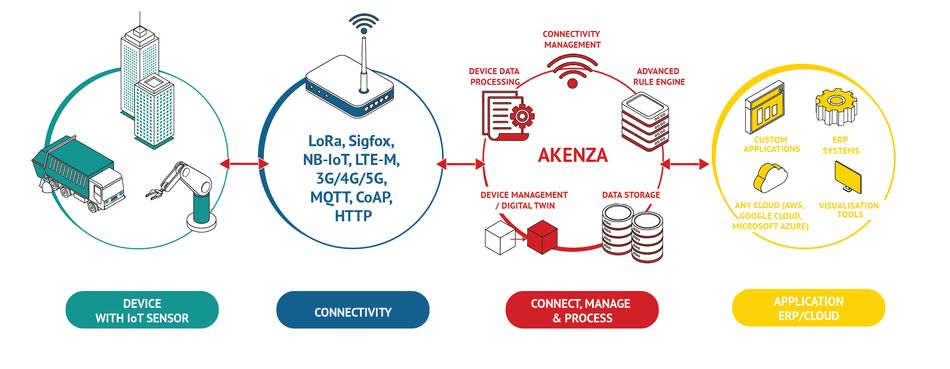
Conclusion
The convergence of the trend towards sensors increasing in quality while decreasing in size and cost with the expansion of the spectrum of LPWAN protocols mean IoT networks can provide real value to enterprises, communities, and cities. The use of low power and wide range networks with smart end-user software solutions opens the possibilities of the potential of IoT to more and more applications and more people. The future of IoT based on long battery-life devices connected by low power wide range networks is bright and will only be enhanced by everyone in the ecosystem recognizing its ongoing complexity and dedicating solutions to value.
About the sponsor: Akenza
Akenza is dedicated to helping companies build their own smart IoT solutions. The Akenza IoT platform can be seen as a bridge between the physical world and the cloud. With a simple and secure management of smart devices, connectivity, and data, it enables the rapid market introduction of innovative, digital technologies. The technology agnostic architecture avoids technology lock-in and makes it possible to register any type of device via any connectivity technology, process the data, and make it available to any application in the cloud.

